One of the biggest trends in wine at the moment is the move to natural wine. It’s a term that has no legal definition, but generally it is considered to be wine that is made without any synthetic herbicides or pesticides and with minimal human intervention. The hippest bars and restaurants in London, Paris, New York, LA and the Nordic countries all feature them heavily on their wine lists. People are looking for something other than big brands, and natural wine feels like the obvious progression, following the trends for local, organic and wild foraged food.
But it also has its detractors. Because of the low intervention approach, some wines can quite simply be faulty, and focusing on an artisanal back story to talk up an imperfect wine has drawn warranted criticism from established wine experts, who are sometimes viewed as the old guard. In the midst of this polarising debate is an unlikely star. Beaujolais. Whereas many people may immediately think of Beaujolais Nouveau and write it off as a fruity wine that tastes like Charms (remember them?), this region of France, which is actually part of Burgundy, is quietly starting to get the recognition it deserves.
With its undulating hills and golden-stoned medieval towns like Oingt and Theizé, Beaujolais is not just pretty, but very accessible. It is also filled with old traditions, which, all of a sudden, are completely on point. Old vineyards, which are hand harvested, stretch as far as the eye can see, with vines up to 100 years old planted in the traditional bush style (not trellised), tightly packed at a metre apart and a metre wide so that the yield is controlled and the fruit is of high quality.
Gamay, the red grape used in Beaujolais, seems to have a happy affinity with the natural wine making process. In the 1950s, when synthetic chemicals where being heralded as the magical answer to weed and disease control in the vineyard, Jules Chauvet, a research scientist who is now considered to be the father of natural wine, was a lone dissenting voice. He cautioned against the use of man-made chemicals, saying that they would destroy the soil. He also advocated for a minimum use of sulphur in the winery. Marcel Lapierre, a Beaujolais winemaker (who died in 2010), was fascinated after meeting Chauvet in 1981, and with three other vignerons – Jean Foillard, Jean-Paul Thévenet and Guy Breton – changed to the traditional way of making Beaujolais. Known as the ‘gang of four’, they were soon joined by a fifth member, Yvon Metras.
Marcel’s children, Camille and Mathieu Lapierre, now run the winery in Morgon, and during my recent trip to Beaujolais, I had a chance to visit it and one of the vineyards beside their family home, where the vines range from 40 to 110 years old. Camille explained how they had tried farming biodynamically in the vineyard but found that it put the natural yeasts they were working with out of balance. For them, it was unnecessary as the soil had never been damaged by synthetic pesticides, so it was better to leave things as they were.
At the winery a short way down the road, Mathieu showed me the traditional equipment that they still use for making their wines. At harvest, the full bunches of grapes from the vineyard are carefully sorted before being put into foudres, which are large wooden fermentation vats, some carbon dioxide is added to fill any remaining space and the vat is closed. Without getting too geeky, here’s the magical science bit. Treating the grapes in this way, which is called carbonic maceration, means that fermentation starts with an enzymatic transformation inside the grape (instead of yeast) and this is what preserves the fruity character of the Gamay grape.
It also means that the wine becomes stable at an early stage, and so minimises the need to use sulphur dioxide. Mathieu explained that when these grapes are then pressed gently in the large traditional wooden basket press, the juice that flows from it is called paradis meaning ‘paradise’ or ‘heaven’. There is so little alcohol in it that even the children are allowed to taste it. This is moved to old oak barrels where wild yeast does the rest of the fermentation, the wine is allowed to age for a short while and then bottled unfiltered. The result is wine that has a pure definition of flavour that is textured and layered.
This approach to wine making has changed how people view Beaujolais, with the wines, many of which are available in Ireland, receiving serious acclaim. A recent study which mapped the different soil types in the 10 Beaujolais Crus, which range from crumbly red granite to blue volcanic rock, has increased interest in the region, and is attracting ambitious young winemakers. I had a particularly interesting tasting on my last day with Rémi Dufaitre, Alex Foillard and Lucas Dutraive who are making spectacular wines, pushing the boundaries and learning as they go.
If you’re visiting France and are near the Beaujolais region, it is well worth planning ahead to visit some of the vineyards. Château de Pizay in Morgon, with its stunning garden, has a great tasting room which also includes an interactive workshop. It is also a Relais Chateau hotel with a very good restaurant. Other vineyards worth visiting are Domaine de la Madone, which is dramatically located on a hill in Fleurie, with its own church and sweeping views all around Beaujolais. There is a wonderfully relaxing restaurant there, so a perfect spot for a late morning visit, followed by lunch.




